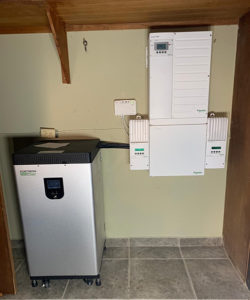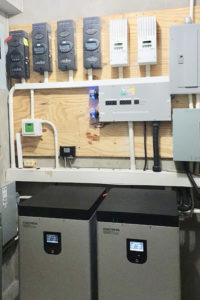
Uopdated 7/4/24
Power Battery Update—Store Energy to Overcome Grid Uncertainty
Keeping your Katahdin Cedar Log Home powered up is important for family safety and protection. Including a home power battery system can be a useful tool for backup power as well as security when the grid is unavailable. Some of the uncertainties of reliance on the power grid have come to light recently. Major storms in the Eastern half of the country can cause extended power outages. On the West Coast, both time-of-use rates and planned outages during fire season can wreak havoc on daily life.
What is time-of-use billing?
Some utilities—mostly on the west coast of the US—use time-of-use billing for residential customers. They charge a variable rate based on the demand for power at certain times of the day. For homeowners in warm climates, operating air conditioning is often essential. But the rates jump up—beginning at 4:00 PM— just when people begin returning to their homes from work and school and immediately crank up the air.
How do planned outages affect homeowners?
Unlike emergency outages, utility customers are notified of planned outages. Recently in California, utilities operating in the region have cut power during windstorms to avoid accidental fires from downed power lines sparking. These outages are dependent on weather forecasts, and unfortunately can last for several days at a time.
 Battery storage maximizes PV production
Battery storage maximizes PV production
While investing in solar photovoltaic (PV) arrays provides homeowners very attractive return on investment, the PV system to will not operate during power outages unless there is battery backup. By integrating battery storage, the solar array will continue to harvest energy, powering your home. Batteries store the excess power generated during the day to be used in the evening. Unfortunately, some utilities have implemented new rate policies to undermine their customers’ solar investment, such as imposing time-of-use rates or cancelling net metering. In those circumstances, battery storage can help you harvest more solar production and reduce your energy costs.
Shopping for reliable energy storage
We spoke with Andrew Parker and Alex Lepore from Fortress Power, a leading battery manufacturer, to see how batteries are being utilized in today’s market. The differences in residential end-use was indeed split between west coast and east coast according to Parker and Lepore. As storage batteries become more common in homes, the market includes several different options, including Tesla’s Powerwall, Panasonic, Pika Energy and others. Most of these options have similar features, including capacity to supplement energy during time-of-use applications and back-up energy storage. But Parker and Lepore noted a key consideration in the types of batteries to consider.
Check the chemistry!
 One important factor in deciding which type of back up storage battery to consider is the actual chemistry that produces the battery power. There are two types of lithium batteries used in residential battery systems. One type is lithium ion nickel manganese cobalt or Li-ion NMC. This is the type of battery used in Tesla vehicles and Powerwalls. And while in unusual circumstances, another factor to consider is that Tesla vehicle batteries have been reported to catch fire due to the temperature-volatile element cobalt. Another type is the lithium iron phosphate or LiFePo4 type of battery. With a long battery life of 12- 15 years and a broad temperature range tolerance, LiFePO4 batteries are quite stable for use within the home setting. These batteries feature these safety and performance systems:
One important factor in deciding which type of back up storage battery to consider is the actual chemistry that produces the battery power. There are two types of lithium batteries used in residential battery systems. One type is lithium ion nickel manganese cobalt or Li-ion NMC. This is the type of battery used in Tesla vehicles and Powerwalls. And while in unusual circumstances, another factor to consider is that Tesla vehicle batteries have been reported to catch fire due to the temperature-volatile element cobalt. Another type is the lithium iron phosphate or LiFePo4 type of battery. With a long battery life of 12- 15 years and a broad temperature range tolerance, LiFePO4 batteries are quite stable for use within the home setting. These batteries feature these safety and performance systems:
- overcharge and deep discharge protection
- overheat protection,
- voltage & temperature monitoring
- cell monitoring & balancing
Fortress e-Vault 18.5 kWh LiFePo4 batteries offer intelligent technology, with the lowest cost per cycle of current battery options. Offering up to 6000 cycles, the e-Vault has a 10-year warranty. And, it can be easily paired with many brands of inverters to convert the battery DC current to household AC power. The e-Vault is scalable and can be installed in sequence to power most homes.
Where’s the best location to plan for battery installation?
For new construction of your Katahdin Cedar Log Home, it’s easy to identify and set aside a location to install the Fortress e-Vault unit. Parker said that just about any space with 4 foot by 4 foot by 4 foot clearance will work for the e-Vault. He recommends garage or basement areas, situated near the main house circuit panel. If installed in a small, separate outbuilding, it’s probably a good idea to include some sort of low-level, vented space heater for colder climates to maximize output, Parker explained.
With their production facility based in Pennsylvania, Fortress offers a network of distributors and installers across the U.S. With the still-healthy federal 30% residential clean energy tax credit, adding energy storage is a viable solution for homeowners hoping to protect their access to power.
